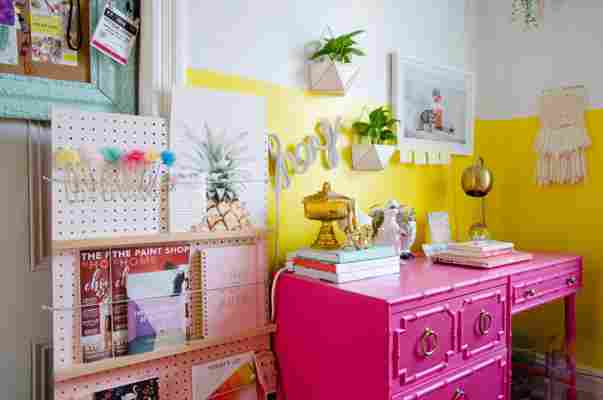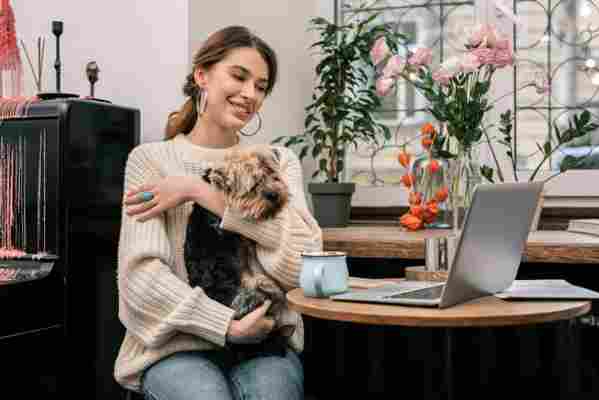
In the last month, I’ve shown a lot of people the inside of my home. I’ve invited my therapist into my tiny backyard, where she commented on my raised bed (and finally met my two dogs). I’ve caught up with a friend quarantined abroad while sitting cross-legged on the floor of my bedroom, surrounded by a little nest of clutter and laundry. And I’ve joined writing groups from my desk in my attic, which I’m now realizing is not quite as tidy when viewed from my laptop camera’s perspective.
These encounters are, of course, all taking place on the video conferencing platforms to which so much of our professional lives—and nearly all of our social lives—have been relegated for the several weeks. On Zoom, FaceTime, and Hangouts, we try to replicate spending time with our friends and family, those who’ve already seen our homes (and maybe even our clutter-nests). But we also allow little glimpses of our private selves to those with whom we might not ordinarily share it. Zoom calls can feel like a low-key treasure hunt of subtle clues about who our professional peers and colleagues really are, when viewed from a perspective we may not normally have access to: the coworker not at their desk or office, but in their natural habitat, surrounded by the quotidian stuff of domestic life.
Seeing a colleague’s toddler or golden retriever wander into the frame is one of the few sources of pure, delirious joy we can hope for these days, and it’s also an unignorable reminder that our colleagues have lives beyond the context of the workplace.
There’s the quiet, voyeuristic pleasure of creeping on one another’s decor decisions , but in the context of work, it’s about more than just measuring up who has an expensive couch or good taste in window curtains. In an office, colleagues with whom we don’t otherwise interact can seem like two-dimensional characters who exist only on weekdays from 9 to 5. When we’re peering into each others’ private spaces, though, everyone suddenly seems so much more human.

SquareFoot , a commercial real estate company based in New York, has about 65 people working in its office, all of whom began working from home in mid-March. Joshua Vickery, the company’s CTO, says that ever since then, he’s been on video calls “more or less constantly” throughout the day. Before, if a colleague was working from home, Vickery says they’d normally choose to dial in to a conference by phone rather than by video (or even turn their video off). That’s changed in the last month.
“It definitely shifts the boundaries of what we do and do not share with each other,” he says. “There are people who have very carefully selected where they take calls from at home, but that’s the minority.” Recently, one of his colleagues called in from her childhood bedroom, where rows of equestrian medals are on display. “Once someone caught on that they were there, she showed them off. And we had a new hire who’s a current equestrian, so they connected over that.”
Alisa Cohn, a start-up coach based in New York, works from home and normally takes her calls in front of a distinctive red painting, which her clients frequently comment on. Cohn, who left New York on the eve of the pandemic, is now thinking about how to work with her new surroundings (she even has a green screen). “I’m looking at what’s behind me, and it’s not perfect—but at least there’s not dirty laundry,” she says. She’s seen some of her clients take calls from their laundry rooms, dens, and, in the case of one young tech startup founder, a parent’s house.
“It’s great, and it’s homey, and it definitely humanizes him,” she says. “I’ve also now met a number of my clients’ kids, who wander into the space. There’s something really wonderfully humanizing about that, and very ‘we’re all in this together’ about that.” Cohn thinks it’s endearing for personal effects to be included in a call’s background, as long as the effect is neat and intentional. (Oh, and also work-appropriate. “I did hear that someone did a video call with an employee who had some off-color paintings in the background,” she says. “Let me just say: not recommended.”)
Seeing a colleague’s toddler or golden retriever wander into the frame is one of the few sources of pure, delirious joy we can hope for these days, and it’s also an unignorable reminder that our colleagues have lives beyond the context of the workplace. (An eternal shout-out here to BBC interviewee Robert Kelly , whose children Kool-Aid Manned their way into his home office during a live interview and instantly became beloved by the internet.) I think catching a glimpse of a coworker’s terrarium collection, or a boss’s framed concert posters, or an intern’s powerlifting trophies, could have a similar effect. A professional’s cubicle might offer a few highly curated clues to what their lives are like after clocking out, but nothing feels more intimate than peering into someone’s home and seeing the ephemera they choose to fill it with.
Unsurprisingly, there is (as of now!) little research on whether video calls from home have any impact on workplace and team dynamics. But research does seem to show that bringing more of our full selves into the workplace can benefit us by giving us more of a sense of control over our own identity, rather than feeling like we’re juggling distinct versions of ourselves at work versus at home. Maryam Kouchaki, an associate professor of management and organizations at Northwestern’s Kellogg School of Management, is behind some of that research. When I asked her how that might extend to our current work-from-home dynamic, she speculated that people may be integrating more of their work and personal identities. “On average, I expect more humanization, more empathy, and cooperation,” she says.
John Kello, a professor of organizational psychology at Davidson College whose research specializes in the science of meetings, is learning the ropes of Zoom just like everyone else. Video conferencing, he says, comes with a bevy of challenges that can result in less engaged colleagues—but he can see how the dynamic could yield better cooperation, too. “I’m not sure just how inter-person perceptions might change, but we do get to see colleagues more in their at-home mode than their at-work mode… it can be humanizing, I guess,” he says. “I could see members of other groups getting a warmer view of each other as a result of the communication-from-home process.” (That empathy, he adds, might also come from everyone clumsily learning the ropes of a new-to-them technology together, and helping each other out along the way.)
While it might feel like we’re all in the same boat, there are drawbacks to the sudden expectation that every nonessential working professional reveal little slices of their domestic spaces to colleagues, as Kyle Chayka wrote about in Curbed . For one, it can feel invasive. A lot of people are already expected to treat work like “family” and make themselves available 24/7; can’t domiciles be one last safe haven from work? (Also: I’m already working; do I really have to tidy my space , too?) For another, it can throw inequalities into stark relief. As a friend remarked to me recently, it’s hard to feel like a team player for a company issuing pay cuts when one’s manager is conferencing in from what is very clearly an impressive vacation home.
When I can’t meet someone in-person, I normally conduct my interviews on the phone. On those calls, I try to get down to business quickly; sometimes I might even write out in advance what I hope to say at the beginning of the call for efficiency’s sake, so I’m not fumbling for words or filling the space with awkward small talk. But when I spoke with Vickery, it was, appropriately, on Zoom.
Before the start of our call, perhaps betraying my own hypothesis, I arranged my laptop’s camera to show little personal effects, beyond some framed artwork and a white wall — my own grasp at “keeping things professional.” Within fifteen minutes, my dog had ambled into the frame and started scratching at the rug (because no one laughs at stiff formality and curation like animals do), and by the end of the call, Vickery was introducing me to his wife and their new kitten. If that’s part of our “new normal,” I don’t hate it.

Leave a Reply